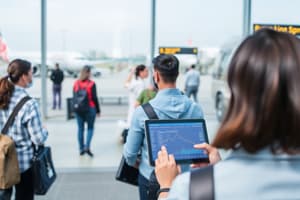Podcast
Questions and Answers
If you have riders on the bus, you should never fuel your bus:
If you have riders on the bus, you should never fuel your bus:
- Without a fire extinguisher beside you
- With any of the windows open
- In a closed building (correct)
A hazard is defined as:
A hazard is defined as:
- Any condition which may cause your trip to be unsafe (correct)
- Another driver only
- A condition of the roadway or weather only
Which of these statements is true about managing space to the sides of your bus?
Which of these statements is true about managing space to the sides of your bus?
- You should keep your bus to the right side of your lane
- You should avoid traveling next to others when possible (correct)
- You should keep your bus to the left side of your lane
When you discharge an unruly rider, you should choose a place:
When you discharge an unruly rider, you should choose a place:
If a rider wants to get on the bus with a car battery or a can of gasoline, you should:
If a rider wants to get on the bus with a car battery or a can of gasoline, you should:
You are driving at night and you must dim your headlights from high to low. What should you do with your speed?
You are driving at night and you must dim your headlights from high to low. What should you do with your speed?
You may sometimes transport small arms ammunition or emergency hospital supplies on a bus. The total weight of these hazardous materials must not exceed ___ pounds.
You may sometimes transport small arms ammunition or emergency hospital supplies on a bus. The total weight of these hazardous materials must not exceed ___ pounds.
When waiting to merge into traffic, you should:
When waiting to merge into traffic, you should:
Your bus is disabled. The bus, with riders on board, may be towed or pushed to a safe spot to discharge the passengers only if:
Your bus is disabled. The bus, with riders on board, may be towed or pushed to a safe spot to discharge the passengers only if:
Baggage or freight carried on a bus must be secured:
Baggage or freight carried on a bus must be secured:
Which of these actions will result in the best control on a curve?
Which of these actions will result in the best control on a curve?
If your bus has an emergency exit door, it must:
If your bus has an emergency exit door, it must:
You should check your mirrors:
You should check your mirrors:
Buses may have recapped or regrooved tires:
Buses may have recapped or regrooved tires:
Drivers of charter buses should NOT allow riders on the bus until:
Drivers of charter buses should NOT allow riders on the bus until:
Carry-on baggage:
Carry-on baggage:
A standee line on the bus:
A standee line on the bus:
Flashcards are hidden until you start studying
Study Notes
Passenger Endorsement Key Facts
- Never fuel a bus with riders on board in a closed building to prevent fire hazards.
- A hazard includes any road, weather, or other conditions that could make your trip unsafe.
- Avoid traveling next to other vehicles to manage space effectively around your bus.
- Discharging an unruly passenger should always occur in the safest possible location.
- Riders cannot bring hazardous materials like car batteries or gasoline onto the bus for safety reasons.
- When dimming headlights at night, reduce speed to adapt to visibility changes.
- The maximum allowable weight for transporting small arms ammunition or emergency hospital supplies on a bus is 500 pounds.
- Always wait for a sufficient gap in traffic before merging to ensure safety.
- If the bus is disabled, it can only be towed with passengers onboard if getting off would be unsafe.
- Baggage or freight must be secured in a way that allows access to emergency exits.
- To maintain control when navigating a curve, slow down before entering and slightly accelerate through it.
- An emergency exit door on a bus must be closed during operation for safety.
- Regularly check mirrors as part of scanning for potential hazards while driving.
- Recapped or regrooved tires are permissible on bus wheels except for the front wheels.
- Riders of charter buses should board only at departure time to ensure safety and organization.
- Carry-on baggage cannot obstruct doorways or aisles to maintain clear evacuation routes.
- The standee line indicates where passengers must remain behind when the bus is in motion for safety.
- Familiarize yourself with your bus's dimensions and speed limits to drive appropriately.
Studying That Suits You
Use AI to generate personalized quizzes and flashcards to suit your learning preferences.




